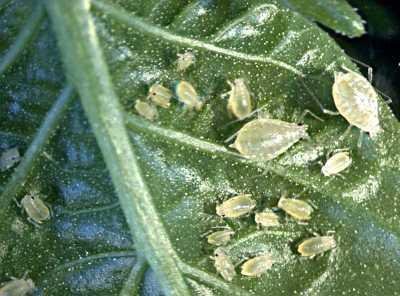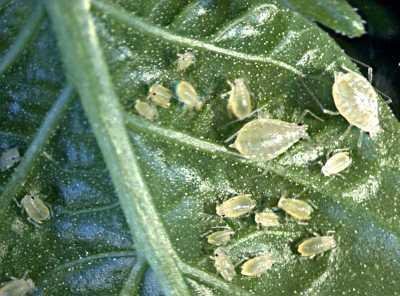

Main aphids in Africa: Black bean aphid ([i]Aphis fabae[/i]), Cabbage aphid ([i]Brevycoryne brassicae/Myzus persicae[/i]), Groundnut aphid ([i]A.craccivora[/i]), Cotton aphid ([i]A.gossypii[/i]), Russian wheat aphid ([i]Diuraphis noxia[/i]), Cypress aphid ([i]Cinara cupressi[/i])
Aphids
Aphids can be serious pests during dry weather. Aphids are a major pest, causing leaves to curl and become unattractive to customers.
Aphids feed by sucking plant sap. Small aphid populations may be relatively harmless, but heavily infested plants usually have wrinkled leaves, stunted growth and deformed pods. Plants, particularly young plants, may dry out and die under heavy aphid attack. Heavy attack on older plants may cause crop loss by decreasing flower and capsule production. Damage may also reduce seed viability.
- Check the plants regularly. Aphids tend to be more common along upwind field borders and next to other leafy vegetable crops or weeds; so initial sampling should be focused in these areas. Because aphid populations are generally clumped within fields, each field should be uniformly sampled.
- Destroy aphids by rubbing them off, or by gently pressing the infested stems or leaves between your fingers. This helps controlling low, initial infestations.
- Apply a strong jet of water to dislodge aphids from attacked plants. When repeated at regular intervals, this method knocks aphid populations down to acceptable levels.
- Remove and destroy infested leaves. This helps reduce further infestations.
- Conserve natural enemies. Ladybird beetles, lacewings, hover fly larvae, parasitic wasps and naturally occurring aphid diseases are common and effective natural enemies of aphids.
